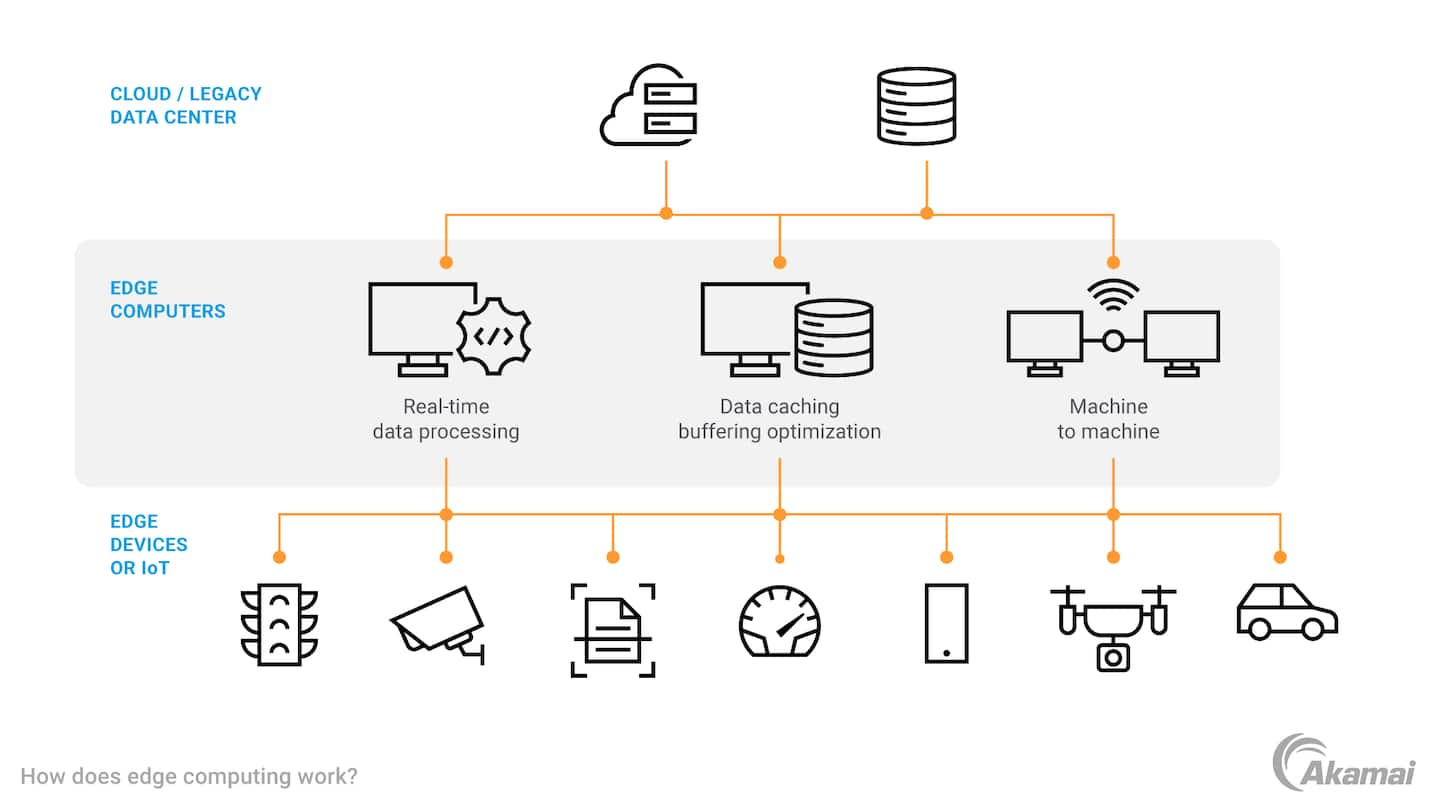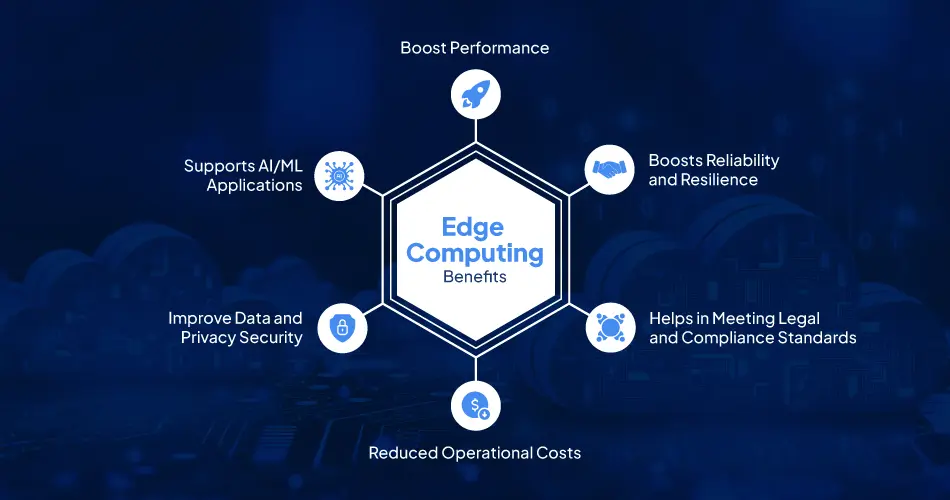Artificial Intelligence powers a growing ecosystem of connected technologies. Market.us estimates that over 15B edge devices are currently deployed worldwide, and the entire edge computing market is e...
Artificial Intelligence powers a growing ecosystem of connected technologies. Market.us estimates that over 15B edge devices are currently deployed worldwide, and the entire edge computing market is expected to grow at a CAGR of 18.3% through 2032. While these technologies are backed by cloud computing, most of them require faster processing than regular cloud-based AI can offer. That’s where edge computing AI comes in, bringing rapid analytics and decision-making directly to users’ devices.
Explore our guide and discover what edge AI is, how it works, and why it’s driving innovation across industries.

Edge Artificial Intelligence is an AI model that processes data directly on edge devices like traffic cameras, smartphones, or wearables. Unlike traditional cloud-based AI, it can make real-time decisions without sending data to centralized cloud facilities. This local processing capability makes edge AI ideal for autonomous vehicles, patient monitoring systems, and other devices requiring immediate responses.
Here’s how it works in practice:

While edge computing and AI pair up to overcome specific limitations of traditional models, they still rely on the cloud to function. Cloud environments provide the infrastructure, tools, and services needed for the complete development cycle of AI models on edge devices.
Mind Supernova experts define several essential ways cloud computing enhances edge AI:
This hybrid approach combines the best of both worlds: the low latency of edge processing and the advanced capabilities of cloud computing. Edge computing handles the immediate decisions, while the cloud manages the broader intelligence and learning processes.
Edge AI technology has already moved beyond being just a trend. For many businesses, it is a new strategic necessity. Companies are turning to edge AI not only to improve performance but also to stay competitive in environments where speed and real-time insights are critical.
Read more: Why Generative AI at the edge is the next big tech move
Edge AI allows organizations to process data and make decisions faster, creating new competitive opportunities. Let’s review its five key advantages.
Edge AI eliminates the delays that plague cloud-based processing by analyzing data directly at its source. This local processing enables organizations to act on the most current information available.
Mind Supernova specialists point out that this performance improvement often determines success or failure in critical scenarios. An autonomous vehicle that processes sensor data locally can avoid a collision, while one dependent on cloud processing might not react in time. Similarly, manufacturing systems that detect equipment defects instantly can help prevent costly damage.
Edge AI technology delivers measurable cost savings across multiple areas:
Data privacy concerns drive many edge Artificial Intelligence implementations. Since information remains at its source, businesses avoid transmitting sensitive data across potentially vulnerable networks. This approach proves especially valuable in industries handling confidential information, such as healthcare, finance, and defense.
Mind Supernova specialists also highlight that edge computing simplifies regulatory compliance. When data never leaves local jurisdiction, companies comply with local regulations rather than navigating multiple cross-border requirements. This streamlined compliance reduces legal risks and administrative overhead.
Edge AI systems maintain functionality during network disruptions or connectivity issues. This autonomy makes them essential for critical applications in remote environments, such as mining operations or emergency response scenarios.
Edge AI also ensures business continuity by maintaining performance during Internet outages. This resilience proves crucial for mission-critical systems where downtime can result in significant costs.
Edge AI’s modular architecture allows organizations to customize implementations for specific operational needs. Businesses can start with focused deployments and expand as requirements evolve. This flexibility enables companies to adapt solutions for different contexts without overhauling entire systems.
Explore more practical advantages of on-device Artificial Intelligence

Edge AI is already transforming how organizations operate, from daily efficiency to mission-critical decisions. Mind Supernova experts highlight high-impact edge AI examples that drive innovation across the following industries:
Healthcare providers face a critical challenge: monitoring patient health effectively while protecting sensitive medical data. AI and edge computing address both concerns. Wearable health monitors with embedded AI analyze vital metrics like heart rate, blood pressure, and glucose levels without sending sensitive data to the cloud. These devices can also detect sudden falls and automatically alert caretakers. AI-enhanced medical equipment can analyze scan results, such as X-rays or MRIs, and provide immediate insights.
Edge AI’s life-saving potential also extends to emergency response scenarios. In ambulances, AI-powered systems can analyze a patient’s vitals in real time to detect early signs of cardiac arrest, stroke, or other critical conditions. This allows paramedics to act quickly and consult physicians with valuable insights before reaching the hospital.
Self-driving cars represent one of the most demanding applications of edge AI. These vehicles rely on local data processing to make split-second decisions based on camera and sensor feedback. When a pedestrian suddenly steps into the road, edge AI detects this event within milliseconds and immediately triggers braking or steering adjustments. This local processing also enables autonomous vehicles to handle unpredictable scenarios like sudden weather changes or uncommon road layouts.
Edge AI is also transforming traffic management systems. By analyzing traffic patterns and driver behavior in real time, it helps improve safety and quickly respond to incidents on the road.
One example is Mind Supernova’s collaboration with Redflex, a provider of intelligent transportation solutions. Our client aimed to expand their service portfolio with a next-generation traffic management system. Our team helped design and develop an AI-driven solution that combines edge computing, computer vision, and deep learning to detect distracted driving behavior with 91% accuracy.
The solution relies on the following three pillars:
With Mind Supernova expertise, Redflex successfully utilized edge computing AI to expand to new markets and launch a high-performance solution that improved driver monitoring capabilities.
Read the full case: Increasing market reach with traffic management and computer vision
The retail industry has witnessed dramatic changes with technologies like pick-and-go stores and smart shopping carts. Amazon’s Just Walk Out technology is one such innovation that demonstrates how edge Artificial Intelligence can reimagine shopping experiences. Just Walk Out enables checkout-free shopping by using edge computer vision, sensor fusion, and AI. It allows customers to skip the long wait at the checkout line, while businesses observe increased operational efficiency and higher profits.
Real-world deployments of this technology show measurable impact. At Lumen Field, a major sports stadium in Seattle, checkout-free stores powered by Just Walk Out led to an 85% increase in transactions and a 112% boost in sales per game. Similarly, Market Express at a London high-traffic exhibition center saw a 56% annual revenue increase and managed to serve 300% more customers during peak days.
Edge AI in manufacturing tackles two persistent challenges: unexpected equipment failures and quality defects. Sensor data enables proactive identification of anomalies and forecasting of machine failures before they occur. Rather than waiting for breakdowns that halt production, manufacturers can schedule maintenance during planned downtime.
In logistics, edge AI enables faster processing of data from sensors, scanners, and IoT devices to improve supply chain visibility and operational efficiency. It helps companies react to real-time conditions by rerouting deliveries or flagging inefficiencies at sorting facilities.
For example, Mind Supernova partnered with a Global Fortune 100 manufacturing client looking to optimize their barcode recognition system. The solution we designed uses industrial Machine Learning to process scanned images locally and accurately recognize damaged or distorted labels. By improving recognition rates and reducing manual interventions, the client was able to cut operational overhead and support their global expansion.
Read the full case here: Driving logistics efficiency with industrial Machine Learning
Most of us are already accustomed to using voice assistants to manage our playlists, lights, and entire homes. But the smarter these systems get, the more data they collect about our private lives. Edge AI tackles such privacy concerns by processing data locally on the device, keeping personal information quite literally under your own roof.
Here are several examples of what edge AI technology makes possible:

Read more: Top 10 edge computing use cases and how to implement them effectively
Implementing edge AI demands a strategic approach that aligns technology choices with business objectives. Our experts offer the following tips for smooth implementation:
Edge environments often involve diverse hardware with different compute, memory, and power limits. Design your edge computing AI models to be hardware-aware. Optimize inference workloads for target devices and test across real-world conditions to ensure reliability and responsiveness.
Edge AI devices need to process raw data locally while securely syncing critical insights with backend systems. Tools like message brokers or edge-to-cloud sync services enable this flow. The goal is to build a unified architecture from edge to cloud that supports interoperability across diverse AI workloads and platforms.
As your edge computing AI usage grows, you’ll need a way to update and scale models efficiently. Use containerization or model versioning tools to simplify rollouts across devices. Plan beyond initial deployment to long-term maintenance, monitoring, and performance tuning at the edge.
Given the complexity of edge AI implementation, many organizations benefit from collaborating with experienced partners. When selecting an AI development partner, evaluate their technology expertise, product development experience, and domain knowledge.
The right partner brings both technical capabilities and strategic guidance, helping navigate common implementation challenges while reducing deployment time. Mind Supernova consultants help their clients turn edge AI into a competitive advantage, speeding innovation while minimizing risks.